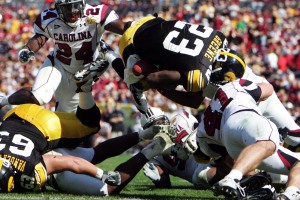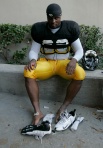 The wildest trip I took this season included seven cities in less than four days, more stops than former Miss California Carrie Prejean on a marriage preservation tour. There was anxiety and enjoyment. It included both Iowa football and basketball.
The wildest trip I took this season included seven cities in less than four days, more stops than former Miss California Carrie Prejean on a marriage preservation tour. There was anxiety and enjoyment. It included both Iowa football and basketball.
I originally slotted my basketball trips in late September. That included Iowa’s game at Ohio State, which was scheduled for 4 p.m. on Dec. 31. Yep, that’s right, New Year’s Eve. Well, I didn’t want to ring in 2009 in Columbus, Ohio so I scheduled a late-evening flight back to Cedar Rapids. I didn’t expect Iowa’s football team would make a New Year’s Day bowl game so I figured I’d just stick to basketball that day.
In early December, Iowa was selected to play in the Outback Bowl in Tampa, Fla., on Jan. 1. I was interested in joining Gazette comrades Marc Morehouse and Mike Hlas in covering the event so I had to rearrange the flight pattern.
The best way I could get from Columbus to Tampa was via Charlotte. I had to leave Columbus at 7:50 p.m. for that flight, but with a 4 p.m. start, making that flight was difficult to say the least. But I tried it anyway.
I flew from Cedar Rapids to Chicago and then Columbus and arrived around midnight on Dec. 30. I staffed a basketball game that appeared to be a blowout in the first half with Ohio State leading 30-15. Then Iowa mounted a major comeback and took the lead in the second half. Needless to say, I was stressed. I wrote most of my story through the game. Iowa had one chance left but freshman Matt Gatens’ last-second three-pointer went astray and Ohio State won 68-65. Had Gatens, who had a great game, hit that shot, the game would have went into overtime and I would have missed my flight. Instead, I made my flight with a few minutes to spare.
I flew to Charlotte first then landed in Tampa around 12:30 a.m. on Jan. 1. Southern cities celebrate the New Year with fireworks, something that surprised me until I realized it’s about 50 degrees warmer there than in Iowa. So it was kind of cool to fly above the fireworks. On the flight to Tampa a depressed couple lamented that they had to kiss each other on the airplane serenaded with a New Year’s countdown by the pilot. Too bad for them.
 By the time I got to the hotel after a stressful trip, it was 1:30 a.m. I arrived at Raymond James Stadium by 8:30 a.m. I watched Iowa beat the living daylights out of South Carolina. I relaxed for a few hours that night before waking at 3 a.m. for a 6 a.m. Eastern flight. I was entertained by the dozens of hungover Iowa fans at the airport, including an old high school friend who hadn’t been to bed since arriving on Dec. 31. Then it was on to Atlanta, St. Louis and then Cedar Rapids.
By the time I got to the hotel after a stressful trip, it was 1:30 a.m. I arrived at Raymond James Stadium by 8:30 a.m. I watched Iowa beat the living daylights out of South Carolina. I relaxed for a few hours that night before waking at 3 a.m. for a 6 a.m. Eastern flight. I was entertained by the dozens of hungover Iowa fans at the airport, including an old high school friend who hadn’t been to bed since arriving on Dec. 31. Then it was on to Atlanta, St. Louis and then Cedar Rapids.
Sportswriters often get hit with comments like “aww, that must be rough” when we travel to cover teams. But none of those people had to staff a basketball game and make a flight within four hours away with a basketball arena 10 miles from the airport. But getting around one day in 70-degree weather in Tampa made it all worth it.



 Posted by scottdo
Posted by scottdo 





